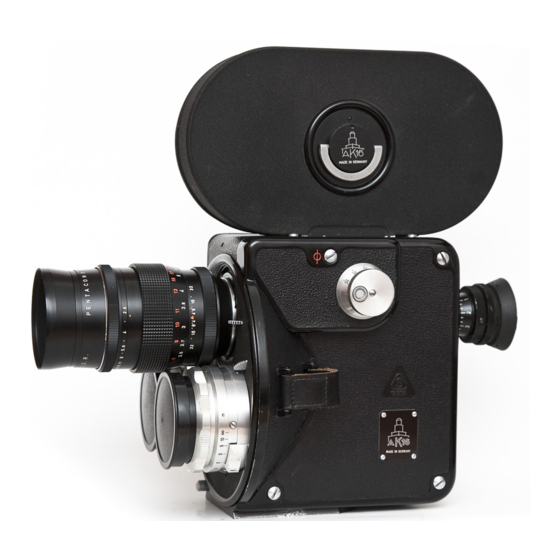
Subscribe to Our Youtube Channel
Summary of Contents for Pentacon PENTAFLEX AK16
- Page 2 PENTAFLEX AK16 OPERATION MANUAL Translated from German...
- Page 3 Good results are guaranteed to you if you read the first recordings before the start of your first recording and have a test piece of film in the hand of the device The ak16 (Image 1) a recording camera for 16mm one or two-sided perforated film, brings through 1hr system many advantages and expansion...
- Page 4 (2) with which a film exchange can be made within a few seconds by the change of the cassette. The cassette (picture 3) carries the entire transport mechanisms - with the exception of the gripper - A sensing-lever-counting device, which always shows the remaining film quantity in meters and / or.
- Page 5 The ak16 (Ref. 4) shows 1m standstill and in the run a right-sided, parallar-free and 10-fold magnified matt screen image, which allows very light and clear dis- evaluation of the image cut-out and the image sharpness. The viewfinder is in the receiving direction. The sector diaphragm of the AK16 can be continuously adjusted (0- closed) in the range of 0 degrees to...
- Page 6 AK16 Lenses (image 7), the following types are available: Original Jena wide angle lens 2.8 / 12.5mm Original Jena standard lenses 1.4 / 25mm Original Jena telephoto lenses 1.4 / 50mm Original Jena telephoto lens 2.8 / 80mm Original Jena telephoto lens 4.0 / 135mm The first 3 lenses are called standard objective ones.
- Page 7 The Ak16 The drive is fitted with a battery- driven battery motor (Fig. 8) that can be attached to the side or from below with a bayonet mount. The speeds are 12,16,20,24 and 32 images / sec. The running accuracy is plus or minus 5% despite the voltage fluctuations between 10.8 and 13 volts.
- Page 8 The AK16 Offers expansion options for a wide variety of special areas, such as hardly any other camera. Accessories for: Image frequencies from 3 to 96 F/per sec. Spring drive Rewinding cartridges Hand crank Single Image Switch Three-phase synchronous motor for 25 B / sec.
- Page 9 Filming in In the 30meter cassette (picture 3 and 9) do not take place in a bright sun. After turning the locking lever (1) upwards and forwards, the cover (2) is lifted off. The empty coil (4) lying in the cassette (3) is pulled out.
- Page 10 For this purpose, the two pressure pads (7) are pressed against one another by light pressure until they engage. As a result, the two tooth drums (8) are released for inserting the film. At the same time, the toothed disc (9) of the counter- platform (10) is moved to the right with simultaneous pivoting inwards until it engages.
- Page 11 The resulting film creep below the full reel may be somewhat smaller but in no case larger than in the diagram. The free end of the film is placed around the lower deflection roller (16), guided through the guide rollers (17) and (18) and fixed on the core of the empty coil (4).
- Page 12 scope of application The 30m rewinding cassette Fade-over and fade-out, with a 30m rewinding cassette in combination with the Ak 16 is possible. This rewinding operation can be performed by hand. I. With the aid of a manual crank which can be screwed to the motor coupling position, as well as by means of an intermediate transmission.
- Page 13 Unlike the 30m cassette, the opposite stage (10) is not swiveled inwards, but remains in a fixed position. The film is inserted into the film channel between the opposite stage and the cassette edge (figure 10) Maintenance and Care The filling channel of the cassette must be cleaned from the time of film dust deposits.
- Page 14 Operational readiness of the camera To insert the cartridge (fig. 12), the handle (19) is turned to "A" with its white marking. This means that the gripper moves out of the movie theater, the transmission is locked and the cassette locking lever moves into the "open"...
- Page 15 This releases the lens and can be removed (Fig. 5). When inserting, it is important to note that the lens nose and the glare drive are plugged into the corresponding receptacles. The easiest way to do this is when the aperture of the lens and the lens mount are rotated to Ansohlag.
- Page 16 removing the motor, pull the motor knob (fig. 13 no. 25) away from the camera and turn it to the left at the same time, after inserting the filled cassette (Fig. 8 nr.26). The AK 16 (30) cassettes (31) are fitted with a gear box (35), the high-performance motor with gearbox (27), the spring mechanism (28), the single image...
- Page 17 battery and the negative pole to the negative pole. The charging current should be 1 amp. Not exceed. Ladedaur about 15 hours charge is terminated when the battery has reached a voltage of approx. 15-16 volt under current. This is about 2.5 to 2.6 volts per cell. After the current has been switched off, the superfluous acid has to be peeled off to the mark.




Need help?
Do you have a question about the PENTAFLEX AK16 and is the answer not in the manual?
Questions and answers